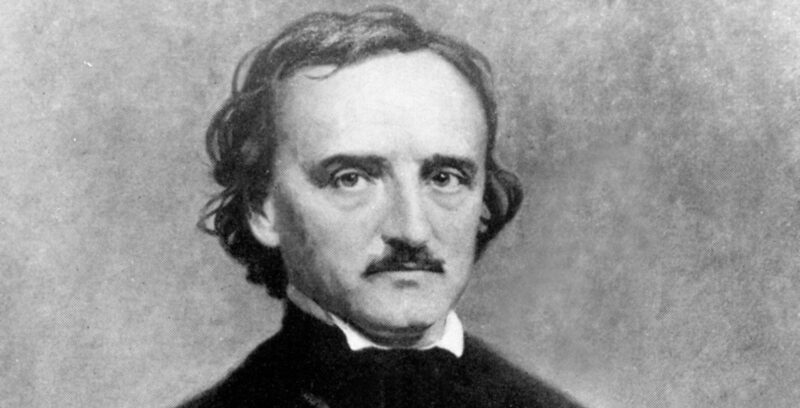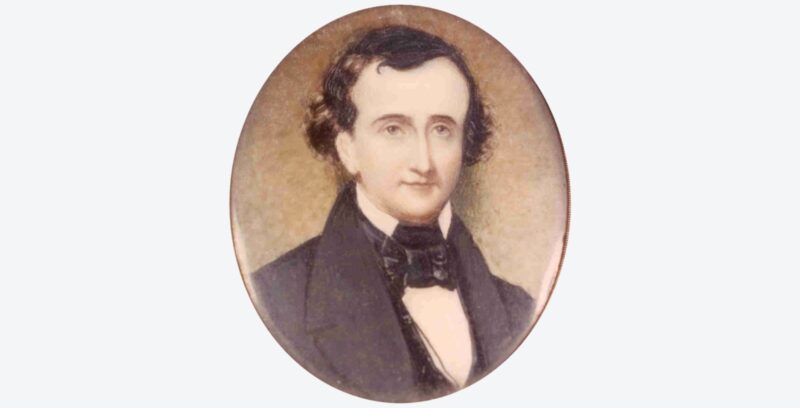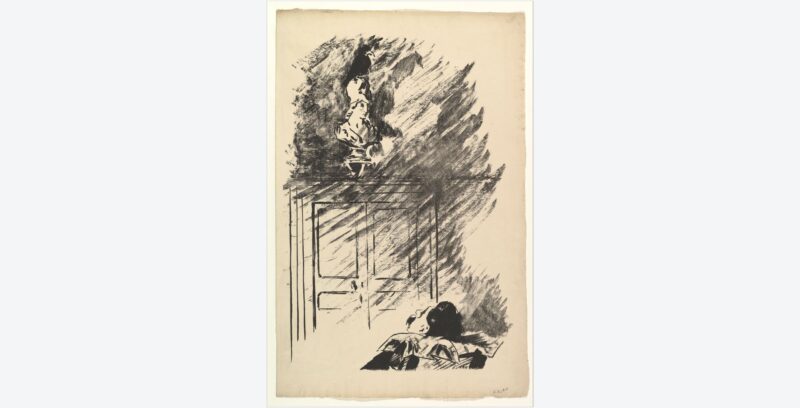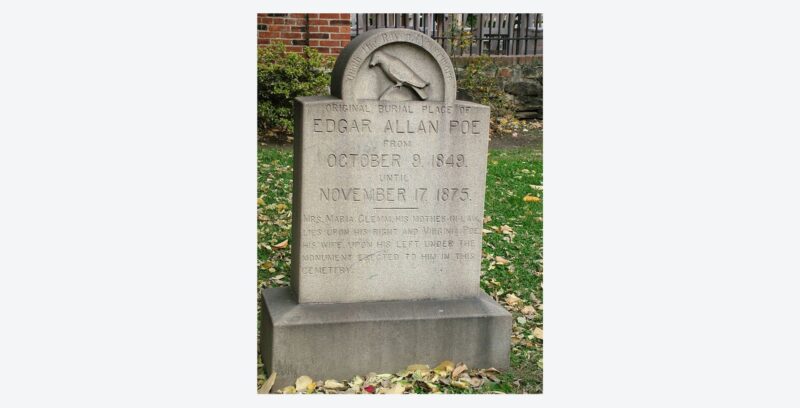We explore the life of Edgar Allan Poe, and his main literary works. In addition, we discuss why he is regarded as one of the universal masters of the short story.

Who was Edgar Allan Poe?
Edgar Allan Poe was a celebrated American writer, regarded as one of the founding fathers of the American short story tradition and a central figure of American Romanticism. His work is considered the starting point of the detective fiction genre, and a contribution of unparalleled influence to horror and science fiction literature.
Poe had a short and tumultuous life, completely devoted to writing. His literary works, which delve into mystery, horror, and the macabre, provided him with a modest livelihood; yet, they have been a unique source of inspiration for subsequent generations of writers.
Poe is an extraordinarily popular figure in contemporary culture, with many of his works having been adapted to various arts and formats: film, animation, and even video games. Today, several of his former homes have been transformed into museums, and the annual literary award given by the Mystery Writers of America bears his name.
- See also: Victor Hugo
Birth and family life of Edgar Allan Poe
Edgar Poe was born in Boston, Massachusetts, on January 18, 1809. His parents were American David Poe Jr. and British Elizabeth Arnold Hopkins, both theater actors. Edgar was the middle child of the couple, William being the eldest, and Rosalie the youngest, born in 1810.
Tragedy marked Edgar's early life. When he was still an infant, his father abandoned the family, leaving his mother to the care of the three siblings. The following year, she succumbed to tuberculosis. Left orphaned, each of the Poe siblings was taken into different homes: William went to the paternal family home in Baltimore, while Edgar and Rosalie were adopted by the Allans and Mckenzies respectively, both from Richmond, Virginia.
John and Frances Allan, Edgar's foster parents, raised and baptized him in the Episcopal faith. Although they never formally adopted him, they did give him their last name. Edgar lived with them until early adulthood.
In 1815, the Allans traveled to the United Kingdom, where Edgar studied in Ayrshire, Scotland, his foster father’s birthplace. Shortly after, in 1816, he studied in London, both in Chelsea and Stoke Newington, before the family returned to Richmond in 1820. In 1825, after receiving a large inheritance, Edgar's foster father purchased a two-story house, which he named "Moldavia".
The following year, Edgar fell in love with Sarah Elmira Royster and also entered the University of Virginia, which he attended for only for 11 months. The institution was in its early stages, and university life was chaotic. Edgar soon found himself immersed in gambling debts, and the financial support from his foster father began to wane. This period marked the onset of family confrontations, leading to a growing estrangement between Edgar and his foster father.
Eventually, Edgar was forced to drop out of university and return home. There, he was met with a rather hostile atmosphere: he was no longer fully welcome at home, and his former sweetheart had married another man. He then made the decision to leave for Boston in 1827.
Boston and military career

While in Boston, Poe used the pseudonym "Henri Le Rennet", and engaged in writing for newspapers and doing clerical work, among other low-paid jobs. However, he still managed to find time to devote himself to a newly discovered passion: writing.
In fact, in 1827 he published his first work: a pamphlet-sized collection of poems in the style of Lord Byron (1788-1824), entitled Tamerlane and Other Poems, which he signed as "a Bostonian". Fifty copies were made, which went totally unnoticed.
That same year, with poverty closing in on him, Poe had no choice but to enlist in the army, which he did under the name Edgar A. Perry. He initially served at Fort Independence in Boston Harbor and later at Fort Moultrie in South Carolina, where he was part of the crew of the brig Waltham and attained his first promotions. Two years later, he became Sergeant Major for Artillery.
With the intention of ending his military service early and enrolling at the Military Academy West Point, New York, to study and pursue a career, Poe decided to resume contact with his foster father. He needed his support to leave the service and enroll at West Point, having had no contact with his family for quite some time.
His foster father, however, still held reservations against him and took several months to reply, not even writing to inform him about the illness of his adoptive mother. Frances Allan died in February 1829, and Poe was finally allowed to visit his family. He reconciled with his foster father, who promised to support his admission to the academy in New York.
Thus, after finding a replacement, Poe left the military service, and before heading to New York, he spent some time in Baltimore with his father's family. There, he wrote his second collection of poems: Al Aaraaf, Tamerlane and Minor Poems, published in 1829.
This second work, centered on an astronomical anecdote by Tycho Brahe (1546-1601) and the Quran’s description of paradise, contains the longest poem Poe ever wrote. It received scant attention and mostly negative reviews, with the exception of writer, editor, and critic John Neal (1793-1876), who gave Poe "the very first words of encouragement I ever remember to have heard", as he himself defined it years later.
Poe finally arrived at West Point in 1830 and enrolled as a cadet. That same year, his foster father married Louisa Patterson, which greatly displeased Poe. His reproaches over this and illegitimate children ultimately estranged Poe from his foster father, who finally decided to disown him.
The life of a writer
Edgar Allan Poe did not last long at the West Point Academy. By 1830, he was determined to be expelled and pursue a life as a writer. Thus, he did everything possible to be court-martialed and dishonorably discharged, which he achieved in less than a year.
In February 1831, while in New York, Poe published his third book, simply called Poems. The funding for this volume came from his former fellow peers at the military academy, each contributing 75 cents to the project.
The book was artfully labeled as a "second edition", since it contained the same long poems from his previous two books, along with six other unpublished works. It was dedicated "To the US Corps of Cadets".
Poe, however, did not stay much longer in New York, as his older brother was seriously ill due to complications derived from alcoholism. In March 1831, he returned to Baltimore and accompanied his brother until his death, in August of the same year.
While in Baltimore, Poe began to move away from poetry and made his early attempts at writing short stories. Times were tough for writers: newspapers and publications were abundant but fleeting, paid little and often delayed, and there was no international copyright law to prevent American publishers from releasing unauthorized copies of British authors rather than support local talent. To make matters worse, the economic crisis of 1837 complicated the situation even further.
The "Panic of 1837" was one of the most severe economic depressions in US history, comparable to the Great Depression of 1929. It started during the initial weeks of Martin Van Buren's (1782-1862) presidency when, in response to certain measures of the previous government, banks announced that they would no longer make their payments in gold and silver coins. This led to a speculative fever followed by a five-year economic depression, during which many banks went bankrupt and unemployment soared.
These circumstances forced Poe to beg for the payment of his works and live in a state of constant economic uncertainty. Still, his prose brought him his first successes. While he was working on what came to be his only theatrical piece, Politian, his first short stories saw the light of day: the weekly periodical Baltimore Saturday Visiter awarded a prize in 1833 to his short story "MS. Found in a Bottle", which opened a space for him in the Southern Literary Messenger in Richmond.
Initially, his role in the periodical was that of contributor: he published "Metzengerstein", considered his first horror tale, followed by "Berenice", which was so shocking that the editors received numerous protest letters from readers. Immediately after, Poe became an editor.
On September 22, 1835, Poe married his cousin on his father’s side, Virginia Clem. He was 26 years old, and she was only 13. By all indications, Poe was a loving and affectionate husband, though that same year he began with his drinking problems. In fact, his sporadic but publicly embarrassing bouts of drinking led to his dismissal from the Southern Literary Messenger in 1837.
Once again, Poe decided to try his luck in New York.
The prolific years
Poe devoted the following years to producing some of his greatest works. In 1838, his only complete novel, The Narrative of Arthur Gordon Pym of Nantucket, was published in New York, which was highly acclaimed. This work is considered the source of inspiration for Moby Dick, by Herman Melville (1819-1891) .
A year later, Poe and his wife moved to Philadelphia, where Burton's Gentleman's Magazine offered him the position of assistant editor. It was in this publication that his tales "William Wilson" and "The Fall of the House of Usher" appeared, the latter being one of his most famous short stories. Many of these tales were compiled in 1840 in his first published collection: Tales of the Grotesque and Arabesque, which received mixed reviews and did not sell well.
That same year, Poe was determined to start his own magazine that was to be called The Penn or The Stylus. He even bought advertising space for it in Philadelphia's Saturday Evening Post, but he would never get his project off the ground.
In 1841 Poe resigned from Burton's Gentleman's Magazine and secured a position at the prestigious Graham's Magazine as a writer and co-editor. There, he published "The Murders in the Rue Morgue", regarded as the first detective story in history.
Around this period, he wrote other prominent short stories that appeared in various publications, such as "The Tell-Tale Heart", "The Black Cat", "The Pit and the Pendulum", and "The Gold-Bug". With the latter, he won a $100 prize from Philadelphia's Dollar Newspaper, bringing him considerable fame in the literary circuit.
In 1842, life took a turn for the worse for Poe. Virginia, his wife, showed the first signs of tuberculosis, which would ultimately claim her life.
The Raven and death of Virginia

Virginia's illness progressed quickly, and Poe faced his wife's health problems with desperation. He began to drink again, and sought better and more stable opportunities. It was thus that Poe approached the Whig Party and the presidency of John Tyler (1790-1862), thanks to the mediation of his friend Frederick Thomas.
Poe aimed for a position in the US Customs Service, but he missed his scheduled interview, citing illness. It is possible that he may have been grappling with alcohol-related issues. Although he was granted a second interview, the available positions had already been filled.
In 1844, Poe resigned from the magazines and decided to return to New York, where he briefly worked as assistant editor for the New York Mirror, run by N. P. Willis, who became his close friend for the remainder of his life. That year he published "The Balloon-Hoax" in The Sun, and the following year, a preview of what was to become his most famous poem: "The Raven", in the New York Mirror.
"The Raven" is a lengthy narrative poem about a mourning lover grieving over the death of his beloved Leonore who receives in his chamber a stealthy visit from a raven at midnight. The bird, perched just out of his reach, continuously evokes his suffering with its cawing, which seems to say "nevermore":
Then, methought, the air grew denser, perfumed from an unseen censer
Swung by Seraphim whose foot-falls tinkled on the tufted floor.
"Wretch," I cried, "thy God hath lent thee—by these angels he hath sent thee
Respite—respite and nepenthe, from thy memories of Lenore!
Quaff, oh quaff this kind nepenthe and forget this lost Lenore!"Quoth the Raven, "Nevermore."
Following its publication in 1845, "The Raven" was replicated in numerous US newspapers, including the New York Tribune, Broadway Journal, and the Southern Literary Messenger, where Poe had formerly worked. The immediate success of this work made its author a nationally renowned writer, though he only received $9 in payment for its publication.
With fame also came the attention of other authors, many of whom Poe had antagonistic relationships with. His literary rivalry with Rufus W. Griswold (1812-1857) is well-known. They even competed for the love of fellow poet Frances Sargent Locke Osgood (1811-1850). Poe had a brief affair with her, to which his dying wife did not object. However, Frances' indiscretions regarding the affair generated a certain scandal in the literary circuit.
Poe then moved from the New York Mirror to the Broadway Journal, and after the disappearance of this journal in 1846, the writer, his mother-in-law and his dying wife relocated to a house in Fordham, in the Bronx, known today as the "Poe Cottage". There, in the master bedroom, Virginia Clemm Poe succumbed to tuberculosis on January 30, 1847.
Poe’s final years

Poe never recovered from Virginia's death. His behavior following the death of his wife became erratic and self-destructive. Throughout 1847, he courted poet Sarah Helen Whitman, with whom he had brief and failed engagement. He also had close but platonic relationships with Annie Richmond and Sarah Anna Lewis, to whom he dedicated poems and from whom he often received financial help.
In 1848, he published "Eureka", a truly remarkable prose poem, considered a stroke of genius by some and described as absurd by others, in which he sought out to explain the universe from a philosophical perspective. Dedicated to Alexander von Humboldt (1769-1859), it revisited old obsessions from his youth, like astronomy, occultism, and metaphysics.
The following year, Poe traveled south, and wandered through Philadelphia and Richmond, where he eventually became engaged to the then widow Elmira Royster. They spent a last happy summer together, in the company of childhood friends and poet Susan Archer Telley, with whom he had a short-lived friendship. Yet, in numerous letters and writings he expressed his longing for death.
Finally, in October 1849, Poe was found in the streets of Baltimore, in a state of delirium and great distress. He was taken to hospital, where he died on October 7, for reasons that remain unknown. He was forty years old and was in such a dire condition that he was unable to explain what had happened to him.
During his agony, Poe is said to have repeated the name "Reynolds", and his final words were "Lord, help my poor soul". Newspapers at the time reported his death with euphemisms like "cerebral inflammation" or "congestion of the brain", often used for alcohol-related deaths.
Legacy of Edgar Allan Poe
Upon the announcement of his death, his long-time rival Rufus W. Griswold published a long and slanted obituary in the New York Tribune under the pseudonym Ludwig, portraying Poe as a lunatic, a nocturnal wanderer who muttered curses in madness. The obituary began with "Edgar Allan Poe is dead. He died in Baltimore the day before yesterday. This announcement will startle many, but few will be grieved by it".
That was not Griswald's last attempt to tarnish Poe's memory. In 1850, he published along with James Russell Lowell and Nathaniel Parker Lewis a compilation of Poe's works, accompanied by a biographical note written by Griswold himself, in which he portrayed Poe as a depraved psychopath and drug addict. Although most claims in this biography were complete and malicious fabrications, which many of Poe's acquaintances denounced, this controversial image of the writer gained popularity among his readers and among those who assumed that, given the morbid themes of his tales, the author must therefore be an evil man himself. A more objective biography of Poe did not appear until 1875.
Poe’s funeral was a simple rite, attended by few people, and he was buried in the courtyard of the Westminster Presbyterian Church in Baltimore. His grave initially only bore the "No. 80" identification, since the marble gravestone with the epitaph his nephew Nelson had paid for was lost in an accident.
Years later, in 1873, poet Paul Hamilton Hayne visited his resting place and published an outraged article about the undignified condition of the grave, which prompted the community to raise funds for a reburial. On October 1, 1875, Poe was reburied in a privileged site in front of the church, with a monument bearing his name, alongside the bodies of his wife and mother-in-law.
Poe's short stories and poems, obsessed with grief, melancholy, and crime, were highly praised by French poets Charles Baudelaire (1821-1867) and Stéphane Mallarmé (1842-1898), to whom Poe owes international fame. Since then, his works have served as a unique source of inspiration for many other great writers, such as Horacio Quiroga (1878-1937), Jorge Luis Borges (1899-1986), H. P. Lovecraft (1890-1937), and Julio Cortázar (1914-1984).
Today, Edgar Allan Poe is regarded as one of the great masters of the short story and a seminal figure in American literature. In addition, he is the father of the detective fiction genre and the horror tale, as well as a prominent thinker on literary theory. His short stories have been widely translated and adapted to film, television, animation, and even video games.
Among Edgar Allan Poe's major and most renowned works are:
- The Narrative of Arthur Gordon Pym of Nantucket (1838 novel)
- "The Fall of the House of Usher" (1839 short story)
- "The Murders in the Rue Morgue" (1841 short story)
- "The Pit and the Pendulum" (1842 short story)
- "The Black Cat" (1843 short story)
- "The Tell-Tale Heart" (1843 short story)
- "The Gold-Bug" (1843 short story)
- "The Purloined Letter" (1844 short story)
- "The Raven" (1845 poem)
- "The Philosophy of Composition" (1846 essay)
- "Eureka" (1848 prose poem or essay)
Referencias
- Barzun, J., Cestre, C. y Mabbott, T. (2023). “Edgar Allan Poe (American writer)”. The Encyclopaedia Britannica. https://www.britannica.com/
- Educ.ar. (2022). Edgar Allan Poe, el inventor del miedo. https://www.educ.ar/
- Reagan Wilson, C. y Ferris, W. (eds.). (1989). “Edgar Allan Poe”. Encyclopedia of Southern Culture. University of North Carolina Press.
- The Poe Museum. (2023). Poe Biography. https://poemuseum.org/
Explore next:
Was this information useful to you?
Yes NoThank you for visiting us :)